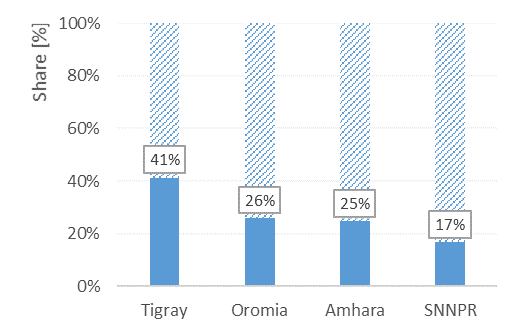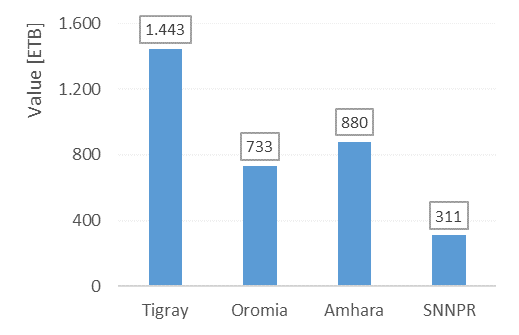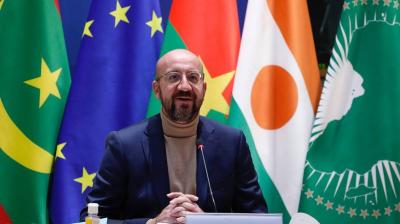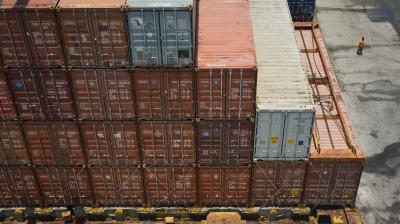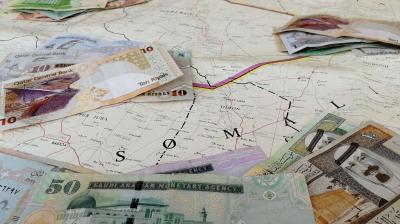The struggle over political finance in Ethiopia’s transition
The political transition ongoing in Ethiopia since 2018 has reconfigured political finance dynamics in the country. Tigray, once a key hub in terms of political finance, has become increasingly marginalized. These developments open up new scenarios for Ethiopia’s political settlement.
The recent conflict in Ethiopia’s Tigray region has been the clearest example of the tensions engulfing the country, which has been witnessing a complex political transition since early 2018.[1] In the cauldron of Ethiopia’s many tensions, this commentary will focus specifically on the confrontation between regional forces trying to assert their autonomy and the federal government seeking to exert control over them. This confrontation has been playing out in many ways, including (but not only) through a struggle for popular legitimacy and through direct military clashes in different regions.[2] Without downplaying the relevance of these important issues, this commentary will analyze one specific dimension of this center-periphery confrontation: the struggle for control over key sources of political finance, i.e. the economic resources used to finance political activity.
The relevance of access to political finance sources has been often emphasized, not least in the case of Ethiopia.[3] Among the many potential sources of political finance, the focus here will be on two: (i) control over state/party-controlled businesses, which politicians can use to allocate favors to selected constituencies; and (ii) control over relatively independent regional budgets, which politicians can tap into to finance preferred policies. The analysis will zoom in on two very different case studies: that of Tigray, a small and peripheral but historically powerful region; and that of Oromia, Ethiopia’s biggest region, and yet a politically marginalized one. The first part of the analysis will explore the major differences between these two regions in terms of available sources of political finance during the Ethiopian People’s Revolutionary Democratic Front (EPRDF) rule. The second part will then show how these dynamics have been changing since the start of Ethiopia’s transition in 2018, with a focus on the changing political fortunes of Tigray.
Dealing the cards: The EPRDF’s Ethiopia
From the fall of the Derg regime in 1991 until recently, Ethiopia’s political order has been dominated by the EPRDF, a coalition of ethnic parties largely controlled by the Tigray People’s Liberation Front (TPLF). As a result of the TPLF’s dominance over Ethiopia’s political settlement, Tigray – a small peripheral region, home to only 6% of the country’s population – came to occupy a very prominent political and economic role, gaining control over major sources of political finance.

Figure 1: Overview of relevant features of Ethiopia's main regions.[4]
First of all, the TPLF’s grip on national politics has enabled the party to wield control over large state-owned enterprises (SOEs), both previously existing ones (e.g. Ethiopian Telecommunications Corporation, Ethiopian Sugar Corporation) and those founded on its own initiative (most notably METEC).[5] In addition, this political dominance has also allowed the TPLF to heavily expand the size and reach of its party-controlled endowment fund, EFFORT, and its numerous subsidiaries.[6]
The benefits arising from control over these companies have not always been apparent at first sight. For instance, in the case of EFFORT, the fund and the party have been formally separated: the fund could not provide direct finance to the party, payment of dividends to individuals was prohibited, and board members (generally TPLF cadres) would not receive formal compensation.[7] Moreover, EFFORT’s scarce performance in terms of profitability has led some analysts to argue that its main purpose may have genuinely been to steer economic activity in Ethiopia, in accordance with the EPRDF’s developmental state ideology.[8]
However, in practice, conglomerates such as EFFORT and METEC have likely provided large amounts of political finance to the TPLF and its regional administration in Tigray. Besides the benefits reaped by individual TPLF cadres,[9] party leaders could use their control over these companies to allocate favors to political allies and selected constituencies – generally in the form of job offers, (sub)contracts, or procurement opportunities.[10] In addition, at the regional level, EFFORT has been the largest taxpayer of the TPLF-controlled Tigray regional administration, contributing to around 25% of its overall revenues.[11]
Alongside state/party-controlled businesses, Tigray’s budget has proved to be another significant source of political finance in the region. To be sure, Ethiopia’s federal arrangement has meant that the regional budget has been far from independent, with over half of its revenues consisting of federal subsidies, and more than a third of its expenditures flowing directly to lower-level administrative authorities to finance service provision.[12] Still, during the EPRDF era, the TPLF-led regional administration has managed to secure a relatively strong fiscal position, raising a large share of its revenues domestically (mostly from taxation),[13] and enjoying political control over a substantial slice of its expenditures, especially when considered in relation to its small population.[14] As a result, the fiscal leeway enjoyed by Tigray has been significantly larger than that of other Ethiopian regions (see Figure 2 and 3), making the regional budget a valuable source of political finance.[15]
|
Figure 2: Share of revenue from domestic sources.[16] |
Figure 3: Per capita expenditure under the |
While the EPRDF rule has seen Tigray become a key hub in Ethiopia’s political and economic system, the situation in Oromia – the country’s most populous region – has been very different. Although formally sharing power with its sister parties within the EPRDF, for decades the TPLF has sought to keep the main levers of power under its own control. As a result, Oromo political forces within the ruling coalition (most notably the Oromo Peoples’ Democratic Organization, OPDO) have not enjoyed control over large national-level SOEs such as METEC, which have remained firmly in the TPLF’s hands.
Instead, OPDO politicians have leveraged their control over other businesses – most notably Oromia’s regional SOEs, whose performance has reportedly been quite positive,[18] as well as the OPDO’s own endowment fund, Tumsa, which features significant trade and export activities and has stakes in major multi-endowment entities.[19] Yet, the (scarce) available information suggests that these region/party-controlled businesses have not been able to match their Tigrayan counterparts in number, size, or reach across sectors and regions.[20] In turn, this has meant that less independent sources of political finance – be it in terms of jobs, contracts, or procurement opportunities – have been available in Oromia as compared to Tigray.
Similarly, the political finance available through Oromia’s regional budget has been less significant than in Tigray, as the TPLF-led federal government has sought to keep Oromia’s regional administration on a relatively short leash. For instance, the regional government’s share of domestic revenues in Oromia has been quite limited, and so has been the share of expenditures under the regional administration’s control.[21] This situation contrasts quite starkly with the higher degree of autonomy enjoyed by Tigray’s regional government, both on the revenue side (less reliance on federal subsidies) and on the expenditure side (control over a larger slice of expenditures). This latter difference has been particularly striking when considered in relation to the two regions’ population: indeed, for each citizen, the amount of budgeted expenditure under regional control in Oromia has been only half of the equivalent figure in Tigray (see Figure 3).[22] This sheds light on the relatively reduced leeway enjoyed by Oromo forces to leverage their regional budget as an independent source of political finance.
Shuffling the cards: Ethiopia’s political transition
The current political transition ongoing in Ethiopia has thrown into question the patterns of control over a number of key political finance sources. In some regions, the impact has been rather modest. In Oromia, for instance, a flurry of changes has shaken the surface (e.g. OPDO’s dissolution and successive inclusion in the Prosperity Party, PP), but has likely changed relatively little in the underlying power dynamics. As during the EPRDF times, Oromia’s regional government remains firmly under the federal government’s control – now via the PP. Moreover, the presence of independent political finance sources in Oromia has continued to be limited. The region’s budget remains heavily dependent on the federal government, and the relevance of state/party-controlled businesses in the region has not shown any major changes. As a result, any new regional administration willing to mount a challenge to the federal government would have little independent financial resources to do so.[23]
In Tigray, by contrast, the political transition ongoing in the country has upended the distribution of the region’s political finance sources. Since early in his term, Prime Minister Abiy Ahmed has sought to limit the TPLF’s control over Ethiopia’s political economy, and to do so he has targeted some of the Front’s key streams of political finance. The first target has been METEC: in less than a year, Abiy has reshuffled the conglomerate’s leadership, arrested scores of its former senior officials on corruption charges, rescinded major state contracts with METEC companies, and set the stage for the group’s split and reorganization.[24] The federal government’s offensive on TPLF-controlled businesses has further intensified during the Tigray conflict. As the conflict has escalated, Tigrayan businesses at large have found themselves harassed,[25] and the federal government has taken particularly strong measures against EFFORT and its subsidiaries, freezing their accounts and assets.[26] In addition, the federal government’s decision to demonetize old currency notes is likely to have wiped out reserves held off the books within the region – thus further eroding independent sources of political finance available to regional forces.[27]
Finally, the eruption of the Tigray conflict has also resulted in a drastic reduction of the fiscal leeway enjoyed by the region’s government. As the conflict escalated, the monthly federal subsidies to the TPLF-led regional administration were first blocked,[28] and then transferred to the new interim administration appointed by the federal government. Moreover, the conflict has drastically eroded the region’s domestic revenue base: with its largest taxpayer (EFFORT) out of the game and amidst a protracted guerrilla warfare, it will likely be hard for the new regional administration to collect its traditional amount of revenues. As a result, Tigray’s budget has become more dependent than ever from the federal government, shutting down another key independent source of political finance in the region.
A new game
The political transition that has started in Ethiopia in 2018 has thus led to a drastic reconfiguration of political finance dynamics in the country. The most remarkable change has been the increasing marginalization of Tigray, once a key hub in terms of political finance. As the TPLF has fallen out with Abiy, the federal government has sought to cut its adversary’s financing streams. So far, the federal government has seemingly been successful in preventing the TPLF from accessing funds via national SOEs or EFFORT, and it has drastically shortened the leash of Tigray’s regional administration through its budget. Yet, the long-term results of this strategy remain to be seen. At the moment, it is not possible to know whether the TPLF may have any other significant sources of political finance; moreover, the federal government itself is in a delicate financial position, thus complicating efforts to assert its authority in the regions.
These dynamics open up new scenarios for Ethiopia’s political settlement. While the fighting continues to rage in Tigray and beyond, analysts should pay close attention to the more hidden economic dynamics that underpin political confrontation in Ethiopia: part of the dispute is taking place there, and understanding this game is going to be crucial to understand developments in the country.
***
Author: Guido Lanfranchi, former Research Intern at Clingendael’s CRU, Horn of Africa Programme
Acknowledgements: Many thanks to Jos Meester for the constant guidance and support, and to Peter Haasbroek for the helpful suggestions.
[1] For a background on Ethiopia’s tensions, see: Yusuf, S. 2019. Drivers of ethnic conflict in contemporary Ethiopia, Institute for Security Studies.
[2] While the case of Tigray has been the most evident, a political and military confrontation between the federal government and regional forces has been going on in Oromia too.
[3] On the Horn of Africa in general, see: de Waal, A. 2015. The real politics of the Horn of Africa: Money, war and the business of power, Cambridge, UK: Polity Press. On the case of Ethiopia more specifically, see: Ishiyama, J. 2012. ‘The politics of Appeasement? Politics and Federal Financial Disbursements: The Case of Ethiopia’, Publius: The Journal of Federalism 42(1), 1-24; Hailu, G. 2019. ‘The Funding of Political Parties in Ethiopia: A Review of Problems’, Oromia Law Journal 8(1), 23-50; Teshome, W. 2009. ‘Political Finance in Africa: Ethiopia as a Case Study’, World Academy of Science, Engineering and Technology 31, 854-867. The same argument has also been applied to the Tigray conflict of November 2020: Melesse, K. 2020. ‘Tigray’s War Against Ethiopia Isn’t About Autonomy. It’s About Economic Power’, Foreign Policy, November 19, https://foreignpolicy.com/2020/11/19/tigray-tplf-war-against-ethiopia-abiy-ahmed-isnt-about-autonomy-its-about-economic-power/ (last accessed 26 January 2021).
[4] Sources: Federal Democratic Republic of Ethiopia. Central Statistical Agency. 2013. Population Projection of Ethiopia for All Regions At Wereda Level from 2014-2017; World Bank. n.a. ‘Public Expenditure and Finance Accountability: Ethiopia’, https://www.pefa.org/country/ethiopia?page=0 (last accessed 26 January 2021); Vaughan, S. and Gebremichael, M. 2011. Rethinking business and people in Ethiopia: The role of EFFORT, the Endowment Fund for Rehabilitation of Tigray, Africa Power and Politics Research Paper n. 02, London: ODI. These four regions have been identified as the main ones due to their population’s size and their political and economic weight.
[5] See, for instance: Gebregziabher, T.N. and Hout, W. 2018. ‘The rise of oligarchy in Ethiopia: the case of wealth creation since 1991’, Review of African Political Economy 45(157), 501-510.
[6] Vaughan and Gebremichael, 2011, op. cit. It is worth noting that EFFORT is not formally owned by the party, but it was established by it and it is controlled by it.
[7] Vaughan and Gebremichael, 2011, op. cit., 12.
[8] Vaughan and Gebremichael, 2011, op. cit.
[9] For hints to the benefits accruing to individuals through ethnic-, party-, and family-based networks around EFFORT, see: Gebreziagbher, T.N. 2019. The Party That Consumes the State: The Rise of Oligarchy in Post-1991 Ethiopia, PhD Dissertation, Institute for Social Studies, 55.
[10] See two key case studies on METEC (Gebreziagbher, T.N. 2019. ‘Soldiers in business: the pitfalls of METEC’s projects in the context of Ethiopia’s civil-military relations’, Review of African Political Economy 46(160), 261-278) and EFFORT (Vaughan and Gebremichael, 2011, op. cit.).
[11] Taxes paid by EFFORT reportedly make up 60% of the regional government’s domestic revenue (Vaughan and Gebremichael, 2011, op. cit., 12). Given that domestic revenues account for around 40% of overall revenue (World Bank. 2019. Public Expenditure and Financial Accountability: Tigray National Regional State, 13), EFFORT taxes amount to 25% of overall revenues.
[12] World Bank, 2019, PEFA Tigray, op. cit. According to the PEFA data, Tigray’s regional administration has received more money from the federal government than what it has disbursed to the lower-level administrative authorities.
[13] Tigray’s regional administration reportedly collects over 40% of its revenues within the region. Around 70-75% of this revenue comes from taxation, especially in the form of direct taxes on income (around two-thirds of all tax revenue) (World Bank, 2019, PEFA Tigray, op. cit., 129-131). As seen above, a large share of this tax revenue is paid by EFFORT.
[14] The expenditure under regional control is calculated as overall expenditure minus the amount of expenditure blocked in the form of subsidies to lower-level administrative authorities. Not all the expenditure under regional control can be spent at the region’s own discretion: some of it is likely to be spent according to priorities established in Addis Ababa, or to be absorbed by service providers (e.g. hospitals, schools, etc.) at the regional level. This calculation thus gives a maximum value of the share of expenditure broadly under regional control. Although not accurate, if used consistently across regions this figure can be useful for comparative purposes.
[15] This analysis has excluded: (i) chartered cities (Addis Ababa, Dire Dawa), whose dynamics are very much different from those of larger regions; (ii) more marginalized regions (e.g. Somali, Afar, Gambella, Benishangul-Gumuz), for which the share of own revenues is very low (generally around 20%) and the data on expenditure under regional control is often not available.
[16] Data sources: several reports on Ethiopia’s regions (available here: World Bank. n.a. ‘Public Expenditure and Finance Accountability: Ethiopia’, https://www.pefa.org/country/ethiopia?page=0 (last accessed 26 January 2021)); Worku, T. 2016. ‘Federal Finance: What can South Sudan and Somalia Learn from their Neighbor Ethiopia?’, The Ethiopian Journal of Business and Economics 6(1), 88-116. Elaboration by the author. This data only refers to the regions’ budgets, and it does not include the financial proceedings of regional SOEs or party-controlled endowment funds.
[17] Data sources: for financial data, see previous footnote; for population data, see 2016-17 estimates by the Ethiopian government (Federal Democratic Republic of Ethiopia. Central Statistical Agency. 2013. Population Projection of Ethiopia for All Regions At Wereda Level from 2014-2017).
[18] In 2017-18, they have reported aggregate profits of around ETB 2 billion (World Bank. 2019. Public Expenditure and Financial Accountability: Oromia National Regional State, 41-42).
[19] See, for instance, Wegagen Bank and Africa Insurance (financial sector), as well as Mega Publishing, Walta Information Center, and Fana Radio (publishing and broadcasting) (Vaughan and Gebremichael, 2011, op. cit., 56-58).
[20] Vaughan and Gebremichael, 2011, op. cit., 56-57; Abegaz, B. 2013. ‘Political Parties in Business: Rent Seekers, Developmentalists, or Both?’, Journal of Development Studies 49(11), 1478. While it would be extremely interesting to know the various funds’ distribution of shares in the multi-endowment joint ventures mentioned above, no data is available.
[21] Oromia’s regional government raises only a quarter of its revenues domestically, and it has political control (as per the definition above) over 55% of its expenditures (World Bank, 2019, PEFA Oromia, op. cit.).
[22] World Bank, 2019, PEFA Oromia, op. cit.; World Bank, 2019, PEFA Tigray, op. cit.; author’s calculation.
[23] It is relevant to note that there is a difference between Oromia’s regional SOEs and Tumsa. Regional SOEs are under the purview of the regional government, and hence a change of power in the government would mean a change of control over these businesses. By contrast, Tumsa has traditionally been under the control of the OPDO. A large part of the party has not merged into the PP, and hence PP’s Oromia branch is expected to enjoy control over Tumsa. It remains unclear how much influence could be wielded over the fund by former high-level OPDO officials that have rejected the transition to the PP.
[24] Fick, M. 2018. ‘Factbox: What is Ethiopia’s METEC?’, Reuters, November 14, https://www.reuters.com/article/us-ethiopia-metec-factbox-idUSKCN1NJ2C2 (last accessed 26 January 2021); Addis Fortune. 2018. ‘Prime Minister Abiy Reshuffles MeTEC Board’, Addis Fortune, May 24, https://addisfortune.net/breaking-news/prime-minister-abiy-reshuffles-metec-board/ (last accessed 26 January 2021); Tadesse, F. ‘MetEC to Start Afresh with New Name’, October 13, https://addisfortune.net/articles/metec-to-start-afresh-with-new-name/ (last accessed 26 January 2021).
[25] Marks, S. and Dahir, A.L. 2020. ‘As War Goes On in Ethiopia, Ethnic Harassment Is on the Rise’, The New York Times, December 12, https://www.nytimes.com/2020/12/12/world/africa/Ethiopia-Tigray-ethnic.html (last accessed 26 January 2021).
[26] FanaBC. 2020. ‘Bank Accounts Of 34 TPLF Financial Institutions Frozen’, Fana Broadcasting Corporate, November 17, https://www.fanabc.com/english/bank-accounts-of-34-tplf-financial-institutions-frozen/ (last accessed 26 January 2021); Africa Confidential. 2020. ‘Citadel falls but the war goes on’, Africa Confidential, December 3, https://www.africa-confidential.com/article/id/13154/Citadel_falls_but_the_war_goes_on (last accessed 26 January 2021). An asset manager has been appointed to oversee the frozen assets while inspections by the Criminal Assets Recovery Directorate are ongoing.
[27] Assefa, W. 2020. ‘Ethiopia's Demonetization - Possible Causes and Effects’, AllAfrica, September 24, https://allafrica.com/stories/202009240666.html (last accessed 26 January 2021). It is not clear whether targeting the TPLF’s “black money” was among the aims of the federal government. However, regardless of the intention, such an operation is likely to have this effect.
[28] The FGE has pledged to give funds directly to lower-level administration, although it is not clear whether/how this has happened, given the crucial role that regional states have as intermediaries between the federal and local level. See: Ayele, Z.A. 2020. ‘Far-sighted federal solidarity, not power politics and legalism, is needed to solve Tigray dispute’, Ethiopia Insight, October 9, https://www.ethiopia-insight.com/2020/10/09/far-sighted-federal-solidarity-not-power-politics-and-legalism-is-needed-to-solve-tigray-dispute/ (last accessed 26 January 2021).




